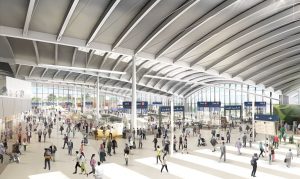 Old Oak and Park Royal Development Corporation has approved the planning application for HS2 Old Oak Common station which will be west-London super hub transport.
Old Oak and Park Royal Development Corporation has approved the planning application for HS2 Old Oak Common station which will be west-London super hub transport.
“The planning approval for the Old Oak Common super-hub station is an important milestone in the delivery of Britain’s new world-class low carbon railway. Building a new railway station for the UK on this scale and size will be an incredible achievement for British engineering,” Matthew Botelle, HS2 Ltd’s Stations Director said.
By this approval, the construction works can progress on building UK largest new railway station ever constructed. The station will have 14 platforms, a mix of six high speed and 8 conventional service platforms, with a 850m long station box, with a volume to fit 6,300 Routemaster buses.
The HS2 Old Oak Common station will incorporate some striking design features, such as an impressive sequence of interlocking curved roof forms which has been designed to enhance the open environment of the station and provide natural ventilation minimising the need for long term energy consumption. The arch forms also reduce the need for columns to support the roof and provide clear sight lines, allowing views across the station to help visitors orientate themselves.
When operational, the station will be used daily by up to an estimated 250,000 passengers and is set to become one of the busiest railway stations in the UK. It will provide seamless connectivity with conventional rail services through eight conventional train platforms, to be served by the Elizabeth Line (Crossrail), Heathrow Express and trains to Wales and the West of England.
The station design has a sufficiently sized concourse and platform space to accommodate passenger growth to 2041 and beyond, provision of a dedicated bus and taxi facility, dedicated drop-off and pickup areas, pedestrian and cycle links, and upgraded highway infrastructure comprising a new traffic signalised junction.
As part of the design, new public spaces are will be created including a new public square directly outside the station. It will include seating and cycle parking and could also be used as a setting for public artwork.
The station design development has been led by WSP with architectural support from WilkinsonEyre.
Share on:



